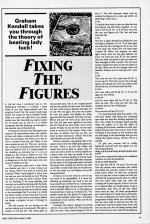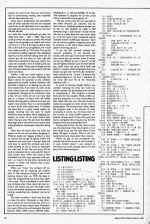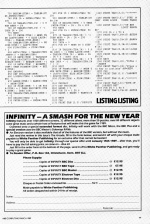
A&B Computing
 1st March 1989
1st March 1989
Categories: Gambling
Author: Graham Kendall
Published in A&B Computing 6.03
Graham Kendall takes you through the theory of beating lady luck!
Fixing The Figures
In the last issue I introduced you to the doubling-up technique in roulette. I hope those of you that experimented with the program, found that the system made huge losses! The reason for this is twofold. Firstly, when you reach the table limit you cannot double your bet. Secondly you need an awful lot of money just to win £1. It is widely recognised that the doubling up technique is the quickest way to financial ruin.
In this series we have now developed two systems. My experiments show that neither of them will make a consistent profit. Do we draw the conclusion that there is no way to win at roulette? Not just yet! There is one more system we can try. This one, I promise, has a chance of working [Where have I heard that one before? - Ed]. It it loosely based on the doubling up principle but it is not so dangerous. Let me put a theory to you. The thing that makes the doubling up technique so dangerous is the fact that every time you lose you double your bet.
The important point here is that when you double your, bet, it is your money you are risking. What if we were to reverse this situation? What would happen if every time we won we were to double our bet? This has the effect of using the bank's money when we are doubling. If we keep doubling (and winning) we would be betting with the banks money, not ours. So even if we were betting with hundreds of pounds we would be happy in the knowledge that if we lose it is mostly the banks money we have lost and not ours. Let us take a closer look at the theory before we design a program to put it through its paces.
We will assume we are betting on red and our staking unit is one pound. We place a pound on red and win. The casino gives us two pounds back, that is our original pound and the one pound we have won. We double our bet as the system dictates and place £2 on red. We win again. This time we receive £4 from the casino, We double our stake again and bet four pounds. This time we lose.
Before this spin we were £3 up. Due to the fact that the spin went against us we have lost £4. Overall we have made a loss of one pound. Already we can see that we are much more in control of this system. Every time we lose, no matter how big our bet, we know we have only lost £1 overall. This is the case whether our bet is £4 or £256.
There is, however, one gaping hole in the system. Every time the wheel goes against us, we lose. There is no half way house, we simply lose and go back to square one. To come out with a profit we need to decide on a figure when we take our profit. If we do not make a conscious decision it will be made for us when we reach the table limit imposed by the casino. If, for arguments sake, we took the house limit as being our barrier and that was £520 it would mean that we would have to win ten times in a row before our profit was guaranteed.
In theory to win ten times in a row is not too much of an impossibility. If it were the doubling up technique we tried in the last issue would have worked for us. It does seem a shame though that one spin in ten can have such a dramatic effect on us. It only losses us one pound but it stops us winning £512. The system would be a lot better if a rogue spin was a minor setback rather than a complete breakdown of our system. What can we do to achieve this?
Consider this option. Instead of starting with £1, let us start with £10. This money we split into four units, these being £4, £3, £2 and £1. We will represent these units by writing the figures on a note pad which we shall keep in front of us.
1234
To decide how much to bet we take the two end figures and add them together. In our case it will be £5 (4+1). If we lose we cross the two end figures off. Our line will now look like this.
1234
Our bet is again decided by adding the two end figures together (3+2). If we lose again we cross the two end figures off. In our case, it will mean the whole line will have been crossed off. When this happens we start again. Every time our line gets deleted we know we have lost £10. So far the system does not look too good. In just two spins we have managed to lose a tenner. Our previous system would have taken at least ten spins to do that. When we do win though, there are benefits. Assume we are starting with a new line.
1234
This time we win. Our stake was £5 (4+1), so we win £5. This time we do not cross any figures off. Instead we write our stake at the end of the line. It will now look like this.
12345
Our next stake will be £6 (5+1). If we win again our line will be
123456
and our next stake will be £7 (6+1). This time we lose. We cross out the two end numbers and our line will become
123456
Our next bet will be £7 (5+2).
Try experimenting with the system. You will soon realise that losing the occasional spin does not stop the winning sequence. In fact, a few losses at strategic points actually helps the system as it has the effect of crossing off the lower numbers so that your stakes will soon be in the tens or even in the hundreds. If you do get to this situation you are still happy in the knowledge that you are risking the casinos money. All but £10 of it anyway.
To give you practise and to totally familiarise yourself with the system try the following sequence.
W W L L W W L W W W W L W W W L W W L W W L W W
If you have mastered the system the undeleted numbers on your line should be
19, 26, 33, 44, 59, 78 and 97
Our next bet will be 116 units. You can see how the system soon increases your stakes and unlike our previous system it does not break down when we have the occasional loss. It is only fair of me to point out that you will find the progressions (as they are called) will end, more often than not, with you crossing off all your figures. In fact if you sat at a roulette table you could expect to get a progression, that went all the way, about once every six days. All other progressions you could expect to break down eventually.
The only consolation you have is that when a progression breaks down you will only have lost ten units. Add to that the fact that the progression may have lasted many hours and you can see you are not losing money hand over foot like you were with the doubling up system. So even if you lose you would have had an entertaining evening that hopefully will not have bankrupt you.
How does a progression end successfully? Like all other systems we have the imposed restriction of the table limit. As an example, if the table limit was 512 units and our line read 236, 332, 457, 326 our next bet would obviously go over the table limit (236 + 326 = 562). This is the point at which we take our profit. We would regard the progression as ended and revert our line to 1,2,3,4. If the figures above were left at the end of our progression we would have made a profit of 1341 units. This can be calculated by adding together the undeleted figures on a line and then taking away ten. Of course, you do not have to wait until the table limit is reached to take your profit. You could set yourself a limit at which point you take your profit. These type of things are the sort of experiments we can conduct with the aid of our micro.
Earlier I said we could expect a progression once every six days. Obviously this figure cannot be accurate as the numbers generated are totally random. However this estimate is based on us betting on just one even chance bet. If we were to cover all six even chance bets we could expect to see a progression, through to its conclusion, once a day. On our micro we can run many days play in a matter of hours with the added benefit of being able to refine and re-test our system very quickly. Also, it is not impossible to cover all six even chance bets. To achieve the same feat in a casino would require six people covering one bet each. It would therefore seem sensible, when designing our system, to cover all six even chance bets rather than just one. We also have the added advantage that if one of the even chance bets is doing badly its counterpart should be doing well.
Now that we know what we want our system to do we can set about designing it. Without doubt our biggest problem is how to control the strings of figures which will represent our note pad. I thought long and hard how to tackle this problem and eventually decided to use an array to represent our note pad. In fact this one array will be used to represent all six note pads for the six even chance bets. When the array is first initialised the first four elements will contain 1, 2, 3 and 4. All the other elements will contain -1, which will indicate that, as yet, they are unused.
When we "cross" the numbers off we will indicate this by replacing the number with -2. The relevance of using -1 and -2 will become clearer later on. With this basis in place the programming was fairly easy, albeit a bit messy. There is probably a much tidier way of doing what I have done but even as I write I still cannot see one. No doubt many of you are already shaking your heads and tut tutting, wondering how anybody can be so stupid.
The other problem I faced was how big to make the array. Obviously in one direction it had to be six elements big. This is to cater for the six even chance bets. Therefore the rows of the array will represent the bets BLACK, RED, PAIR (even), IMPAIR (odd), MANQUE (1 to 18) and PASSE (19 to 36). This standard is adopted for all the arrays that are used within the program.
The size of the array, for our note pad, in the other direction (i.e. columns) was my main concern. I basically picked a number out of the air and decided to make it 200 elements large. I tald myself I would review this size at a later date but have never done so. In all the tests I have conducted (which included several 10,000 spin sessions) I have yet to come up against a subscript error and as memory is not short there seems little point in worrying about it.
If you do find yourself running into memory problems, as. you develop the system, this note pad array could well be an area where you can reclaim some. It would not be too difficult to put a trace on to find out the highest element used. Or alternatively, you could make the array fairly small and build in a routine which compresses the array should you get near the limit. By compress I mean remove all the -1's and -2's and put the undeleted figures in the first n elements of the array and then fill all the remaining elements with -1.
A word of warning though. Before you consider reducing the array too much you should consider the processing time involved in compressing it. The program is already fairly slow for two reasons. Firstly, unlike our previous programs, it is now controlling six bets rather than just one. This fact obviously makes the program six times slower than its predecessors. The second factor which makes the program slow is the amount of array processing it carries out. To keep track of, and control, an array 6x200 requires a fair amount of loop work. If every few spins you had to reorganise this array you may find the program becomes unacceptably slow.
Having said all that I do not want to give you the impression that the program is too slow to be of any use. My tests show it does about 83 spins a minute. That is still one hundred and sixty times faster than a casino.
When we get to the procedures that actually control this array we will consider it in even further detail. I just wanted to introduce you to the concept early as it is the basis of the whole program.
This article was converted to a web page from the following pages of A&B Computing 6.03.




